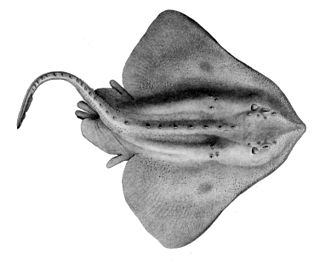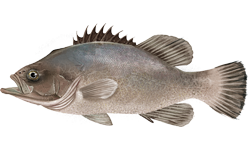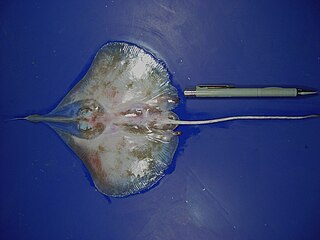
Skates are cartilaginous fish belonging to the family Rajidae in the superorder Batoidea of rays. More than 150 species have been described, in 17 genera. Softnose skates and pygmy skates were previously treated as subfamilies of Rajidae, but are now considered as distinct families. Alternatively, the name "skate" is used to refer to the entire order of Rajiformes.

The wreckfish are a small group of ray-finned fish in the genus Polyprion, belonging to the monotypic family Polyprionidae in the order Acropomatiformes.

The Anacanthobatidae, the smooth skates or leg skates, are a family of skates found at depths below 200 m (660 ft) in the Indian, Pacific and Atlantic Oceans.

Dipturus is a large genus of skates native to the Pacific, Atlantic, and Indian Oceans. They were formerly included in Raja. Some species initially moved to Dipturus were later placed in Dentiraja, Spiniraja, and Zearaja.

The blue skate, also known as the grey skate or blue-grey skate, is a species of cartilaginous fish, a ray, belonging to the family Rajidae, the skates. It was formerly considered to be conspecific with the flapper skate, the combined taxon being known as the common skate. Historically, it was one of the most abundant skates in the northeast Atlantic Ocean and the Mediterranean Sea. Despite its name, today it appears to be absent from much of this range. Where previously abundant, fisheries directly targeted this skate and elsewhere it is caught incidentally as bycatch. The former species was uplisted to critically endangered on the IUCN Red List in 2006 and it is protected within the EU.
The spotted legskate is a species of cartilaginous fish, a ray belonging to the family Anacanthobatidae, the smooth skates. It is the only species in the monospecific genus Anacanthobatis. It is found off Mozambique and South Africa. This is a demersal fish occurring on soft substrates on the continental shelf break and upper continental slope at depths of 200–435 m (656–1,427 ft).

Rostroraja is a genus of skate belonging to the family Rajidae, native to the Atlantic Ocean and East Pacific, including the Mediterranean, Caribbean, Gulf of Mexico and Gulf of California. The genus was considered monotypic in the past, but a number of species usually classified in Raja have been reassigned to this genus based on genetic analysis.

Plectropomus, commonly known as the coral groupers, is a genus of marine ray-finned fish, groupers from the subfamily Epinephelinae, part of the family Serranidae, which also includes the anthias and sea basses. They are found in the Indo-Pacific region.

Conodon is a genus of grunts native to the Pacific and Atlantic coasts of the Americas. The currently recognized species in this genus are:

Arhynchobatidae is a family of skates whose members are commonly known as the softnose skates. It belongs to the order Rajiformes in the superorder Batoidea of rays. At least 104 species have been described, in 13 genera. Softnose skates have at times been placed in the same family as hardnose skates, but most recent authors recognize them as a distinct family. Members of the Arhynchobatidae can be distinguished from hardnose skates in having a soft and flexible snout, as well as a more or less reduced rostrum.

Springeria is a genus of cartilaginous fish belonging to the family Anacanthobatidae, the smooth skates. The two species in this genus are found in the central Western Atlantic.

Zearaja is a small genus of skates in the family Rajidae. It currently consists of four described species found in oceans off New Zealand, Tasmania and southern South America.

Bangana is a genus of fish in the family Cyprinidae, the carps and minnows. It is distributed across much of southern and eastern Asia. Species live mainly in the flowing waters of tropical and subtropical rivers.

Pseudocaranx is a genus of ray-finned fishes from the family Carangidae, the jacks, trevallies, scads, and pompanos. They occur in the western Atlantic Ocean and the Indo-Pacific.

Caliraja rhina, commonly known as the longnose skate, is a species of skate in the family Rajidae from the northeast Pacific. It is found from the eastern Bering Sea and Alaska to Baja California and the Gulf of California. The longnose skate is found at depths of 9–1,069 m (30–3,507 ft) and often deeper than the big skate. The longnose skate was briefly associated with the genus Beringraja, having been previously included in Raja until genetic evidence supported reclassification. It was then reclassified into the new Caliraja genus after an analysis of egg case morphology and the number of embryos per egg case. This issue has not be completely resolved and the scientific names "Raja rhina" and "Beringraja rhina" are still in widespread use.

The flapper skate is a species of cartilaginous fish, a ray, belonging to the family Rajidae, the skates. It was formerly considered to be conspecific with the blue skate, the combined taxon being known as the common skate. The flapper skate is found in the Eastern Atlantic Ocean, although its range has contracted to a considerable extent due to overfishing, and it is classified by the International Union for Conservation of Nature as Critically Endangered. It is the largest species of skate in the World.
Strongylura strongylura, the spottail needlefish or blackspot longtom, is a species of needlefish from the family Belonidae. It is found in the Indian and western Pacific Oceans from the Persian Gulf east to Australia and the Philippines. This species occurs in coastal waters and in mangrove-lined lagoons as well as being recorded in estuarine areas and it has even entered freshwater. Living S. strongylura have been found alive and buried in mud during low tide. It is piscivorous, feeding mainly on clupeoids. This species is oviparous and the eggs adhere to objects in the water which catch the tendrils which cover the surface of the egg. Strongylura strongylura under the synonym of Strongylura caudimaculata is the type species of the genus Strongylura. It as originally described as Belone strongylura by Johan Coenraad van Hasselt in 1823 with the type locality given as Vizagapatam, India.

Brachygenys is a genus of marine ray-finned fish, grunts belonging to the family Haemulidae. The species within the genus are found in the eastern Pacific Ocean and western Atlantic Ocean. It is not yet recognised by Fishbase but is by the Catalog of Fishes.
The spinynose sculpin is a species of marine ray-finned fish belonging to the family Cottidae, the typical sculpins. It is found in the northeastern Pacific Ocean from Alaska south to Washington and the San Juan Islands. The spinynose sculpin is the only species in the monospecific genus Asemichthys. This sculpin lays its eggs on the egg masses of the buffalo sculpin, thought to be a strategy to take advantage of the larger fish’s egg guarding behaviour.

Caliraja is a genus of cartilaginous fish, rays, belonging to the family Rajidae, the skates. These skates are found in the Eastern Pacific Ocean.
















